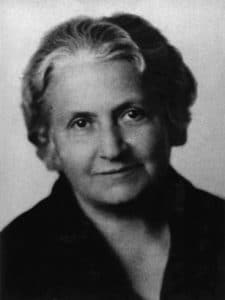Montessori Method of Education

Dr. Maria Montessori
Mrs Virbalaben Dalal was inspired by the Montessori method of education and did her Montessori Teacher’s Training Course in Kolkata. She then taught at Shreyas School in Ahemdabad, whose Founder President was Madame Montessori.
“Education should no longer be mostly imparting of knowledge, but must take a new path, seeking the release of human potentialities.
My vision of the future is no longer of people taking exams and proceeding on that certification…. but of individuals passing from one stage of independence of higher, by means of their own activity, through their own efforts of will, which constitutes the inner evolution of the individual.“
Dr. Maria Montessori
Dr. Maria Montessori (1870-1952) was an Italian physician and anthropologist who devoted her life to understanding how children develop socially, intellectually, physically, and spiritually.
She carefully observed children over many years and developed a universal pattern of learning, which is termed as the Montessori Method of Education, namely:
The 5 Principles of the Montessori Method are:
- Respect is the foundation of the Montessori Learning: Children Are Shown Respect.
- Minds: The young mind is ready and eager to learn, nurture it.
- Sensitive Periods: Are Critical For Learning.
- Prepared Environment: Children learn best in environment prepared for learning.
- Auto-education: Children can learn themselves through the right environment for learning.
Dr Montessori identified the following environment for education:
Children aged 6 to 12 years:
- Provide opportunities for collaborative intellectual development in which the child’s interests are encouraged, supported and guided
- Encourage the development of self-confidence, imagination, intellectual independence and self-efficacy
- Foster an understanding of the child’s role in their community, in their culture and in the natural world
To enable these principles, the Montessori classrooms are beautifully crafted environments designed to meet the needs of children in a specific age range. Dr. Maria Montessori discovered that experiential learning in this type of classroom led to a deeper understanding of language, mathematics, science, music, social interactions and much more.
Every material in a Montessori classroom supports an aspect of child development, creating a match between the child’s natural interests and the available activities. Children can learn through their own experience and at their own pace. They can respond at any moment to the natural curiosities that exist in all humans and build a solid foundation for life-long learning.
In Montessori classrooms children make creative choices in their learning, while the classroom and the highly trained teacher offer age-appropriate activities to guide the process.
Dr Montessori identified the following key components:
- Children Are Individuals Dr Montessori worked on the basis that every child has creative potential, but should be treated as an individual.
- Nurturing Natural Potential Dr Montessori believed that children’s natural potential should be nurtured, to help them learn and develop and that a healthy environment at nurseries, school and home environments can help this natural potential to emerge.
- Children Need Freedom Dr Montessori’s beliefs was that children need to be given more freedom and encouraged to learn. She believed that children shouldn’t be pushed to complete activities in certain set times and that they should do it in their own time. However, this doesn’t mean complete freedom with no rules, but rather that appropriate guidelines should be provided with a social group, to encourage learning. She also believed that children should have a choice about what activities they try and that should try and learn to be self-sufficient.
- Mixed Age Groups Generally early education tends to split children into different groups according to their age, under the Montessori approach, there is the belief that it’s good to have mixed age groups.
Rather than hindering a child’s progress, it’s believed that it will help all of the children to develop on a social and intellectual basis, at their pace which is best for them. - The Importance Of Equipment
Dr Montessori’s belief was that all children should be taught with care and kindness and that they should be able to have access to good quality equipment to support their learning.
Many of the play equipment were specifically designed to learn mathematics, mass, volume and spatial awareness.
Who Was Maria Montessori?
Dr Maria Montessori [1870-1952], was an Italian physician and anthropologist who devoted her life to understanding how children develop socially, intellectually, emotionally, physically and spiritually. By careful observation and researching children all over the world, she discovered some universal patterns of learning and development in children, regardless of culture or religion.
Dr Montessori was one of the first women to be granted a diploma as a physician in Italy. Following her interest in human development, she assisted a clinic for children with mental illnesses. She later directed the Orthophrenic School in Rome for children with physical, mental and emotional challenges.
During this time Dr Montessori lectured throughout Europe, in relation to changing the attitudes to child development and the need for improved education of children and their value and importance the future of our societies.
In 1907 Dr Montessori was given the responsibility of caring for a group of children in the Rome’s slum district. She began to see the importance of positive, nurturing environment that changes with the development needs of the child, and the impact this had on their learning. As she observed the children, she saw them demonstrate capabilities and interests that exceeded her expectations.
Dr Montessori used these skills to develop sets of material over a period of many years namely the “Montessori Method of Education”. She created a concrete, physical representation of these concepts into training material and skillsets that that motivate and encourage child development naturally to learn as part of their normal course of development.
Montessori Education was designed over a period of many years by Dr. Maria Montessori and her associates, creating a concrete, physical representation of the concepts and skills that children are naturally motivated to learn in their normal course of development.
Dr. Montessori conducted her first international training course in Italy in 1913, and her first American training course in California in 1915. As she carried her vision around the world, she felt that a time had come to ensure the quality and integrity of what was being handed down in her training courses. For that reason, she founded the Association Montessori International (AMI) in 1929. Today AMI continues to support quality teacher training worldwide.
In her later years, Montessori travelled extensively throughout Europe, India, and even to America giving lectures, teaching training courses, visiting schools, and displaying her classroom’s at exhibitions. She received many honours and was even nominated for the Nobel Peace Prize three times in 1949, 1950 and 1951 and continued working, teaching and writing up to the time of her death in 1952.
She also received numerous honours and titles throughout Europe. In the year before her death, she taught her last teacher-training course and spoke at the International Montessori Council (IMC), many of her talks focused on educating children to live peaceably. Dr Montessori gave the world a new way to educate children, a way that brought life and discovery to learning.
Dr Maria Montessori
